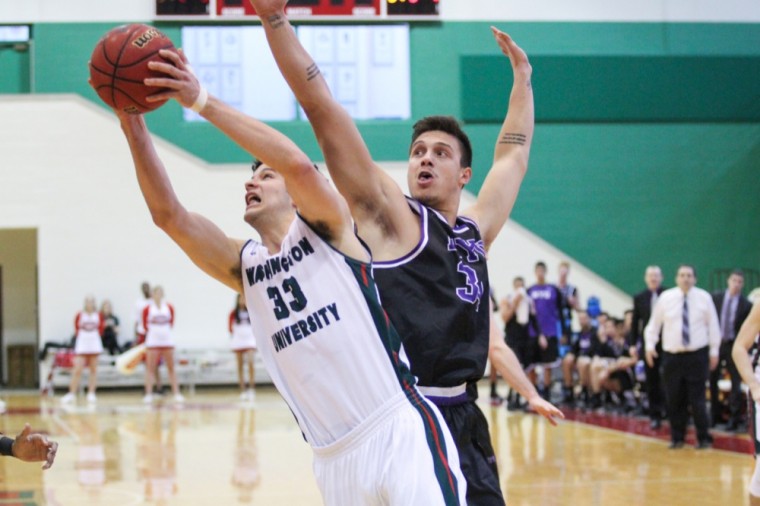Athlete Profile
For Sanders, size doesn’t matter
If you attend a Washington University men’s basketball practice, you might hear Andrew Sanders before you see him.
Draped by players more than a few inches taller than him, the 6-foot-5-inch sophomore power forward leaps up, and with a quick flash of silver jersey and the concussive smack of hand-on-ball, pulls down a rebound. At the other end of the floor, a couple of seconds later, he settles in the low post and with a squeaky quick pivot-step, muscles up and finishes near the net.

Sophomore Andrew Sanders takes a shot at the Bears’ game against New York University on Jan. 24. The forward averages 15.8 points per game thus far this season.
“He’s just kind of this animal…he’s a beast,” sophomore point guard Kevin Kucera said.
Ferocious is probably the best way to describe Sanders’ game. With only 25 career games under his belt, he already leads the team in points and rebounds per game with 15.8 and 7.6, respectively, while maintaining an efficient 0.530. He does all this while playing in the low post, body-to-body, against men three to four inches taller than him. Since elegantly shooting over his opponents (like Dirk Nowitzki) is mostly out of the question, Sanders must rely on strength and mobility to finish high near the net.
“It’s not about the size at all,” Kucera said. “He can go up against a 6-foot-9-inch kid like we did against New York [University] and hold his own.”
“Coaches are always looking for the tallest player they can find and making them into a great basketball player,” Sanders said, “but I’ve been playing undersized my whole life, so that’s nothing new to me.”
At home, Sanders was the youngest of three boys, all accomplished athletes. The middle child, Matt, is a captain on the baseball team at Harvard University, and the oldest played high school football in a program that produced multiple NFL talents.
“I’ve always had older brothers, so I’ve always gotten pushed around,” Sanders said.
Now that he has the height advantage, Sanders jokes that he does the pushing.
That kind of effort comes at no small expense to his body, but he doesn’t seem to mind. The Tuesday before the team traveled to Case Western Reserve University, Sanders sprained his ankle in practice. Three days later, he put up a career-high 26 against the Spartans. He’s also nursing a strained tendon on his thumb, but it appears to take much more than that to slow him down.

Forward Andrew Sanders shoots a free throw during the Bears’ game against New York University this past weekend. The sophomore from Tampa, Fla., was named UAA athlete of the week on Jan. 4.
Excluding Sunday’s game against NYU, where he fell into foul trouble early, Sanders is enjoying an elite stretch of three games where he has averaged 23 points and 9.3 boards. Around this time a year ago, you might not have even known his name.
In the last week of January 2015, Sanders was just starting to see marginal minutes on the floor. By the year’s end he had averaged 4.7 minutes per game, with 1 point and 1.6 rebounds. Despite the uninspiring stat line, head coach Mark Edwards asserted that back then Sanders was clearly part of the long-term future of Wash. U. basketball.
“He really wasn’t a fringe player,” Edwards said. “He was maybe statistically, but every day in practice we saw him as being a very key component to the program.”
When 4-5 of the Bears’ starting five either graduated or moved on, Sanders saw the opportunity.
“There [were] a lot of minutes to go around, and no one really knew who was going to get them,” Sanders said.
During preseason practice, there is a first, second, third team, et cetera. Players will occasionally rotate in and out, but, for the most part, the first team is for the starting five.
Sanders remembers starting on the second team, eventually breaking into the top tier as the preseason progressed.
When asked what spurred the promotion, Edwards echoed the same grinding attitude that has allowed Sanders to succeed all season at both ends of the court.
“He finishes,” Edwards said. “A big thing in college basketball…the whole key thing is, can you finish? Can you finish in the offense you started? Can you finish on defense? And that is one of Andrew’s strengths.”
Sanders currently has a team-high six double-doubles on the season and nearly a third of his 121 rebounds have come off the offensive glass.
“He runs like a guard too,” Kucera said. “He’s a tight end out there. That’s an apt comparison given that Sanders played tight end on the high school JV [team].”
Although Sanders ended up taking first team reps throughout the preseason, the excitement of starting set in when coach Edwards released the scouting report that details the defensive assignments for the first game.
“[If your name is on there], that’s how you know that you’re starting,” Sanders said.
He told his parents after the report came out.
“They definitely didn’t expect me to play as much as I had or score as much as I had,” Sanders said.
With their son a featured player for one of the most successful Division III basketball programs, the Tampa, Florida mom and dad are making their second in-season trip up to St. Louis this coming weekend. Luckily the two are already veteran road warriors from the older brother’s athletic exploits.
When they arrive at the Field House on Friday night, Sanders and the team will be waiting, warmed up and ready to battle. The Bears are currently in the middle of a 2-4 stretch, during which they have lost three conference games by a total of seven points. The players are mad. Edwards is mad. Sanders is mad and ready to run out onto the court and make noise.
